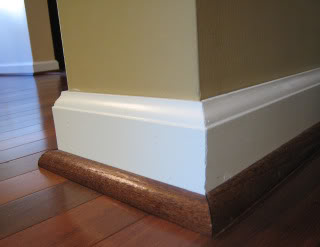Baseboard Trim

Baseboard trim, also known as base trim or base molding, runs along the wall at the floor. Besides the fabulous decorating options which baseboards provide, they are also extremely functional, protecting the bottom of your walls from damage.
Benefits of Baseboard Trim
- Keeps dirt from accumulating in the gap between walls and floors
- Helps stop insects from making their way into the house
- Protects the bottom edge of the wall from moisture and other types of damage
- Safeguards against vacuum cleaner bumps and scratches
- Hides uneven flooring edges for a smooth finished look
- Allows for expansion and contraction of wooden floorboards
Baseboard Features
Baseboard trim is usually 2 to 8” in height and may come as one long strip or separate pieces. You can choose the height of your baseboards to be larger or smaller than the standard size. Thicker baseboard pieces allow for more intricate designs on the wood.
Baseboard materials include wood (usually an inexpensive softwood such as pine), MDF or other composites, vinyl, and plastic. While natural and engineered wood are easy to paint in your choice of color, vinyl and plastic require less maintenance over time.
Baseboard Tips
1. Select a baseboard to blend with your casings in order to help blend the room design. Casings, used to cover the gap between drywall and the frame, go around the doors to protect them. Baseboards are usually narrower than the casings.
2. Don't skimp on baseboard height. Choose taller baseboard trim for a more elegant-looking room.
3. When you're installing baseboards as a DIY project, adhere with glue or caulk. It's a lot easier than the precision nailing normally used for baseboards. (Dry fit the pieces first for best results.)
4. If you'd prefer a more polished look, hire a professional carpenter to cut and nail your baseboard trim in place.
One Blogger's Elegant Baseboard Design
Read about this blogger's baseboard design at Thrifty Decor Chick.


Updated August 16, 2018.
Looking for a Pro? Call us (866) 441-6648

Carpentry Average Costs
Carpenters Experiences

Professional Stain Adds The Finishing Touch To My New Cedar Deck

Concrete Patio Is The Finishing Touch For An Artist's Studio




